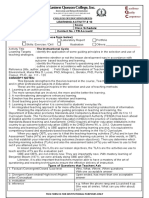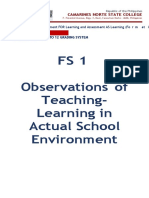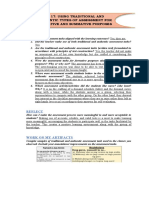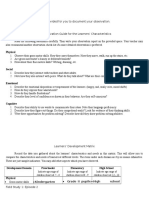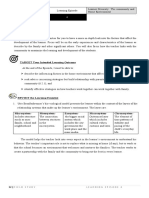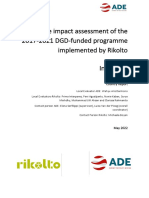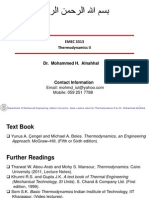FS 1 Le10
FS 1 Le10
Uploaded by
Jorebell W. QuiminoCopyright:
Available Formats
FS 1 Le10
FS 1 Le10
Uploaded by
Jorebell W. QuiminoOriginal Description:
Original Title
Copyright
Available Formats
Share this document
Did you find this document useful?
Is this content inappropriate?
Copyright:
Available Formats
FS 1 Le10
FS 1 Le10
Uploaded by
Jorebell W. QuiminoCopyright:
Available Formats
Activity 10.
1 Applying the Guiding Principles in the Selection and Use of Strategies
OBSERVE
Observe one class with the use of the observation sheet for greater focus then analyze my
observations with the help of the guide questions.
1. The more senses that are involved, The teacher made use of a PowerPoint Presentation,
the more and the better the learning. integrating images and videos for learning and a
visible timer in giving out activities to the learners.
2. Learning is an active process. The teacher encourages everybody to participate as
it will be an advantage to their performance tasks.
3. A non-threatening atmosphere The teacher sees to it that the learning space is safe
enhances learning and free from any kind of threat.
4. Emotion has the power to increase The sanity of every learner is highly considered.
retention and learning. The teacher makes sure every learner is free from
unwanted emotional problem issues.
5. Good teaching goes beyond the The teacher asks the students how they were able to
recall of information. apply what they have known.
6. Learning is meaningful when it is The teacher lets the students give what they have
connected to a student’s everyday life. learned at the end of the lesson and relate them to
real-life applications.
7. An integrated teaching approach is The teacher did not just focus on the book content
far more effective than teaching but maximized the use of the internet to search for
isolated bits of information. additional knowledge and information to be taught.
ANALYZE
What is the best method of teaching? Is there such a thing?
There is no specific best method of teaching because, for me, it can be measured by what
kind of teacher you are, and what kind of students are you teaching. In short, it depends mainly
on circumstances. What appears to be the best method to some, may not be the same for others.
That is why, as teachers, we need the ability to assess and organize the methods that will be
effective in the teaching-learning process.
REFLECT
Reflect on this question.
How do we select the appropriate strategy for our lessons?
Before selecting relevant materials for the lesson, identify first the Learning
Objectives for the course.
Organize teaching strategies in accordance with the goals to be achieved.
Alignment of assessments to be utilized in connection with the desired learning
outcome.
Learn and connect with the students to know what strategies are required and
which need to be disregarded for an effective teaching and learning process.
Activity 10.2 Determining Outcome-Based Teaching and Learning
OBSERVE
Observe a class and answer the following questions.
1. Did the Teacher state the learning objectives/ intended learning outcomes? (ILOs) at the
beginning of the class? Did he/she share them with the class? How?
Before the presentation of the lesson, the teacher took some time to introduce the
intended learning outcomes to the learners. The teacher emphasized presenting,
reminding the students that this is going to serve as their compass throughout the lesson.
2. What teaching-learning activities (TLAs) did he/she use? Did these TLAs help him/her
attain his/her lesson objectives/ ILOs? Explain your answer.
The Teacher made use of table samples and graphs to show the students the actual
connection between the two, and how a graph is crafted in an orderly manner. These
helped her attain the lesson objective.
3. What assessment task/s did the teacher employ? are these aligned with the lesson objectives/
ILOs?
The assessment task utilized by the teacher is graphing wherein, students do the graphing
on the chalkboard in a limited time. To further assess their performance, she prepared a
seatwork and did a simple peer learning/tutorial for those we term slow learners.
ANALYZE
1. What are your thoughts about Outcome-Based Teaching and Learning (OBTL)?
Outcome-Based Teaching and Learning is far more effective and beneficial not only to
the students but to the teacher as well. When you focus on the outcome, you have to give
it your best in the very first place where the most basic step is done. The traditional type
of learning is not a reliable one to measure how the student knows. Unlike the OBTL,
students are thoroughly guided and facilitated well by the teacher. As a result, they know
how to relate the concepts they acquired to real-life situations which makes it easier to
reach the intended outcome for learning, as they are the DOER or the Action Takers on
things that matter in life.
Activity 10.3 Applying Effective Questioning Techniques
OBSERVE
Types of Question Examples of Questions that the Resource Teacher
Asked
1. Factual/ Convergent Define Economics.
Closed/ Low Level
2. Divergent/ Higher-order/ Open- Enumerate concepts or ideas related to the word
ended/ conceptual economics.
a. evaluation Any volunteer to give a simple recall on our past
lesson?
b. inference What is your role as a consumer? As a producer?
c. comparison How does the Law of Demand differ from the Law of
Supply?
d. application Given the power and freedom of purchasing anything
under the sun, how are you going to behave as a wise
consumer?
e. problem-solving Imagine yourself as a producer and you are expecting
a price increase in your product this coming month,
what are you going to do as a wise decision-maker and
responsible at the same time?
3. Affective Is it important to learn the concept of Economics?
Does it make a difference if we disregard the study of
it?
Why do you say so?
ANALYZE
1. Neil Postman once said: “Children go to school as question marks and leave school as
periods! “Does this have something to do with the type of questions that teachers ask and the
questioning and reacting techniques that they employ?
The type of questions the teachers ask their students could be one influential factor
relative to the statement. As children enter school with much curiosity and questions in
their minds, teachers who serve as their compass help them navigate into the kind of
world they’ve been looking for. In this sense, learners who entered the gate as question
marks would come out as periods since what they’ve been looking for has been granted
by the place, they’ve entered.
REFLECT
The importance of using various reacting techniques
The use of various reacting techniques is vital to learning. The teacher,
whose goal is to provide learners with a good environment for learning is
expected to have the skills in choosing the kind of behavioral reaction to employ
in different situations during the learning process. This only means that the
teacher must be vigilant in making reactions where there is appropriateness
when dealing with the students. This kind of mindset will build emotional and
social responsibility in the teacher-learner relationship, and this is what makes
up good learning.
You might also like
- UNIT 9-PHY 131-Chapter 14-Heat-StudentsDocument32 pagesUNIT 9-PHY 131-Chapter 14-Heat-StudentscharlieNo ratings yet
- LAS 10 The Instructional CycleDocument5 pagesLAS 10 The Instructional CycleHiezel G LandichoNo ratings yet
- Episode 10Document8 pagesEpisode 10Noviegen CardenteNo ratings yet
- FIELD STUDY 1 Episode 11 13 FinalDocument76 pagesFIELD STUDY 1 Episode 11 13 FinalLors ArcaNo ratings yet
- FS 1 Le12Document1 pageFS 1 Le12Jorebell W. QuiminoNo ratings yet
- FS 1 Ep. 3 DoneDocument15 pagesFS 1 Ep. 3 DoneRylNo ratings yet
- Source Ep 12Document17 pagesSource Ep 12Jan Paulyne CastillejosNo ratings yet
- Field Study 1 Le 14-16Document21 pagesField Study 1 Le 14-16Cherryl SiquigNo ratings yet
- Episode 18Document11 pagesEpisode 18PRESIDENT GAMINGNo ratings yet
- Field Study 1 (Episode3)Document9 pagesField Study 1 (Episode3)Ms.BaeNo ratings yet
- FS2 Le17Document2 pagesFS2 Le17Jorebell W. QuiminoNo ratings yet
- FS2 Episode 1Document7 pagesFS2 Episode 1Jeremy BersanoNo ratings yet
- Field StudyDocument4 pagesField StudyzharinaNo ratings yet
- Field Study 1 - Episode 12 - DDocument12 pagesField Study 1 - Episode 12 - DsNo ratings yet
- Eps 13 DoneDocument28 pagesEps 13 DoneMharilyn E BatalliaNo ratings yet
- FS2 Le15Document5 pagesFS2 Le15John Michael TapallaNo ratings yet
- Template FS 1 Episode 6Document5 pagesTemplate FS 1 Episode 6Erika Mae DelatorreNo ratings yet
- fs1 Episode 5Document7 pagesfs1 Episode 5Jamille Nympha C. BalasiNo ratings yet
- Episode 11 16Document33 pagesEpisode 11 16mark san andresNo ratings yet
- FS 1 Activity 12Document3 pagesFS 1 Activity 12SWEET JEAN CASABALNo ratings yet
- FS 2 Episode 2.Document18 pagesFS 2 Episode 2.Harold Emmanuel M. LlonaNo ratings yet
- Episode 15Document6 pagesEpisode 15Ma C KyNo ratings yet
- Ep 14-fs1Document7 pagesEp 14-fs1Jeny MontillaNo ratings yet
- Activity 4.1 (FS1)Document7 pagesActivity 4.1 (FS1)Tobio KageyamaNo ratings yet
- fs2 1Document6 pagesfs2 1Noviegen CardenteNo ratings yet
- FS 1 - Episode 6Document5 pagesFS 1 - Episode 6Bhabierhose Saliwan LhacroNo ratings yet
- FS 2 - Episode 13-15Document20 pagesFS 2 - Episode 13-15Esther Italia LoridaNo ratings yet
- Field Study 1 Episode 13Document32 pagesField Study 1 Episode 13Mharilyn E BatalliaNo ratings yet
- Learning Episode 3 - Field Study 2Document4 pagesLearning Episode 3 - Field Study 2JUSTICENo ratings yet
- Marga Sendfs1 - 13Document37 pagesMarga Sendfs1 - 13Angelo BolanteNo ratings yet
- Close Encounter With The School CurriculumDocument6 pagesClose Encounter With The School CurriculumBane LazoNo ratings yet
- FS 1 Episode 2Document12 pagesFS 1 Episode 2guillermo desaculaNo ratings yet
- Learning Episode 13 B in Field Study 1Document19 pagesLearning Episode 13 B in Field Study 1payno gelacioNo ratings yet
- Episode 6Document4 pagesEpisode 6Ladiemirr IldefonsoNo ratings yet
- FS2 Ep15Document8 pagesFS2 Ep15Kent BernabeNo ratings yet
- Classroom Management MatrixDocument1 pageClassroom Management MatrixLenard Justine CamachoNo ratings yet
- Fs1 Learning Episode 11 To 15Document28 pagesFs1 Learning Episode 11 To 15JoyShaira Delgado RojoNo ratings yet
- Answer Module 1 Sctaboso Prof - Ed. Bec1 SupplementalDocument30 pagesAnswer Module 1 Sctaboso Prof - Ed. Bec1 Supplementalsherlyn tabosoNo ratings yet
- FS 1 Episode 13-15Document30 pagesFS 1 Episode 13-15Jayson LumontadNo ratings yet
- FS2 Le9Document3 pagesFS2 Le9Jorebell W. QuiminoNo ratings yet
- Fs-1-Ep-4 DoneDocument13 pagesFs-1-Ep-4 DoneAlyzza Javier Vidad IINo ratings yet
- FS 1 Ep 12Document12 pagesFS 1 Ep 12Monette GarciaNo ratings yet
- FS 1 Le08Document4 pagesFS 1 Le08Jorebell W. QuiminoNo ratings yet
- E Portfolio FinalDocument86 pagesE Portfolio FinalRhea SuaminaNo ratings yet
- Activity 5 6Document14 pagesActivity 5 6camilo reyesNo ratings yet
- fs1 Ep12 UpdatedDocument9 pagesfs1 Ep12 UpdatedMillet CastilloNo ratings yet
- The Instructional Cycle: Spark Your InterestDocument50 pagesThe Instructional Cycle: Spark Your InterestAnd'z MirabuenoNo ratings yet
- FS2-Episode 3Document4 pagesFS2-Episode 3Angela MagallanesNo ratings yet
- Field Study 2 Learning Episode 1...Document27 pagesField Study 2 Learning Episode 1...Ryan Joseph Delos SantosNo ratings yet
- Field Study 1 E13Document8 pagesField Study 1 E13Maria Kristena CaballeroNo ratings yet
- Fs2-Episode 1Document7 pagesFs2-Episode 1Jamille Nympha C. BalasiNo ratings yet
- FS1 Ep13Document4 pagesFS1 Ep13Margie BorjaNo ratings yet
- Fs1 Episode 3 VinceDocument24 pagesFs1 Episode 3 VinceJohn Vince RebagodaNo ratings yet
- Saint Mary's University: Learning Episode 18Document5 pagesSaint Mary's University: Learning Episode 18Ryan VicenteNo ratings yet
- FS 1 Learning Ep 08Document13 pagesFS 1 Learning Ep 08Albie keen BarrosNo ratings yet
- FS1-Episode 3Document9 pagesFS1-Episode 3Angela MagallanesNo ratings yet
- Tario Lim Memorial Campus: Spark Your InterestDocument8 pagesTario Lim Memorial Campus: Spark Your Interestantonette cruzNo ratings yet
- Field Study 1 EPISODE 3Document19 pagesField Study 1 EPISODE 3Zyrelle RuizNo ratings yet
- Learning Episode 9Document9 pagesLearning Episode 9Mark Anthony Nieva RafalloNo ratings yet
- Learning Episode 3 Final 1Document11 pagesLearning Episode 3 Final 1Mirielle Boladola-Logronio AbieraNo ratings yet
- My Teacher is My Hero: Tributes to the People Who Gave Us Knowledge, Motivation, and WisdonFrom EverandMy Teacher is My Hero: Tributes to the People Who Gave Us Knowledge, Motivation, and WisdonNo ratings yet
- FS 1 Le13Document11 pagesFS 1 Le13Jorebell W. QuiminoNo ratings yet
- FS 1 Le15Document3 pagesFS 1 Le15Jorebell W. QuiminoNo ratings yet
- FS 1 Le11Document8 pagesFS 1 Le11Jorebell W. QuiminoNo ratings yet
- FS 1 Le14Document2 pagesFS 1 Le14Jorebell W. QuiminoNo ratings yet
- FS 1 Le09Document4 pagesFS 1 Le09Jorebell W. QuiminoNo ratings yet
- FS 1 Le 05Document4 pagesFS 1 Le 05Jorebell W. QuiminoNo ratings yet
- FS 1 Le 07Document3 pagesFS 1 Le 07Jorebell W. QuiminoNo ratings yet
- FS 1 Le08Document4 pagesFS 1 Le08Jorebell W. QuiminoNo ratings yet
- FS 1 Le 06Document2 pagesFS 1 Le 06Jorebell W. QuiminoNo ratings yet
- FS 1 Le 03Document7 pagesFS 1 Le 03Jorebell W. QuiminoNo ratings yet
- FS1 Le 02Document3 pagesFS1 Le 02Jorebell W. QuiminoNo ratings yet
- FS2 Le19Document3 pagesFS2 Le19Jorebell W. QuiminoNo ratings yet
- FS2 Le18Document1 pageFS2 Le18Jorebell W. QuiminoNo ratings yet
- FS2 Le17Document2 pagesFS2 Le17Jorebell W. QuiminoNo ratings yet
- FS 1-Le 01Document7 pagesFS 1-Le 01Jorebell W. QuiminoNo ratings yet
- FS2 Le12Document2 pagesFS2 Le12Jorebell W. QuiminoNo ratings yet
- FS2 Le16Document1 pageFS2 Le16Jorebell W. QuiminoNo ratings yet
- FS2 Le10Document3 pagesFS2 Le10Jorebell W. QuiminoNo ratings yet
- FS2 Le2Document1 pageFS2 Le2Jorebell W. QuiminoNo ratings yet
- FS2 Le11Document2 pagesFS2 Le11Jorebell W. QuiminoNo ratings yet
- FS2 Le5Document2 pagesFS2 Le5Jorebell W. QuiminoNo ratings yet
- FS2 Le3Document1 pageFS2 Le3Jorebell W. QuiminoNo ratings yet
- FS2 Le4Document1 pageFS2 Le4Jorebell W. QuiminoNo ratings yet
- FS2 Le9Document3 pagesFS2 Le9Jorebell W. QuiminoNo ratings yet
- FS2 Le1Document2 pagesFS2 Le1Jorebell W. QuiminoNo ratings yet
- Rmaniae (Classical Philology Xvi 1921)Document6 pagesRmaniae (Classical Philology Xvi 1921)Giacomo PediniNo ratings yet
- LAI-122452741 - DRF - Key Fact Statement - SignedDocument4 pagesLAI-122452741 - DRF - Key Fact Statement - Signedgamersingh098123No ratings yet
- Ethics Quiz 1Document3 pagesEthics Quiz 1Tanesh ThompsonNo ratings yet
- People & Qualities - Lua Geok Chiau MoeDocument6 pagesPeople & Qualities - Lua Geok Chiau Moerichard limNo ratings yet
- Paper Pool ReportDocument3 pagesPaper Pool Reportapi-254295669No ratings yet
- Advanced Practice Individual AssignmentDocument8 pagesAdvanced Practice Individual AssignmentJay SayNo ratings yet
- Intermediate AccountingDocument12 pagesIntermediate AccountingpolxrixNo ratings yet
- Collaborative Assignment Sheet Fall20Document3 pagesCollaborative Assignment Sheet Fall20api-535145753No ratings yet
- CHAPTER IV KamalDocument19 pagesCHAPTER IV KamalABNo ratings yet
- Positive Psychology What Is The Perma ModelDocument2 pagesPositive Psychology What Is The Perma ModelZarious RaskminofNo ratings yet
- H4A71110 Vol-3 AllDocument147 pagesH4A71110 Vol-3 AllRhonny AlbertoNo ratings yet
- Part 1: Geotechnical Properties and Exploration of SoilDocument7 pagesPart 1: Geotechnical Properties and Exploration of SoilAadolf ElÿasNo ratings yet
- Podger Spanner Sizes PDFDocument1 pagePodger Spanner Sizes PDFScooby DooNo ratings yet
- Basic Linux Commands: Click To Edit Master Subtitle StyleDocument20 pagesBasic Linux Commands: Click To Edit Master Subtitle StylepritpalkakuNo ratings yet
- TD Anglais Tech Final ElecDocument3 pagesTD Anglais Tech Final ElecDjafar Christophe UmbaNo ratings yet
- B17108-R5E - Cylinder Line Scuffing Prevention Measure at 0.1% ShulphurDocument12 pagesB17108-R5E - Cylinder Line Scuffing Prevention Measure at 0.1% ShulphurS.K.SEONo ratings yet
- A4 NTN Freedom Paper Jig 2012Document3 pagesA4 NTN Freedom Paper Jig 2012lingonNo ratings yet
- Coconut Aminos - Everything You Need To KnowDocument10 pagesCoconut Aminos - Everything You Need To KnowT ChenNo ratings yet
- Budget of The Lesson - MapehDocument3 pagesBudget of The Lesson - MapehAlven ReyNo ratings yet
- Chapter 4.0Document105 pagesChapter 4.0adlenaeliyaNo ratings yet
- Endlive Evaluation RikoltoDocument46 pagesEndlive Evaluation RikoltoFajar KurniawanNo ratings yet
- Thermodynamics II - Chapter 8 - V 1.3Document38 pagesThermodynamics II - Chapter 8 - V 1.3Faisal SafadiNo ratings yet
- BIO201 Lab 1Document9 pagesBIO201 Lab 1dperezmorgado1No ratings yet
- Inst Book mc8000Document105 pagesInst Book mc8000simonNo ratings yet
- Acer Aspire Hidden Partion RestorationDocument2 pagesAcer Aspire Hidden Partion Restorationjimmel_1999No ratings yet
- Effects of Evaporator Frosting On The Performance of An Air-to-Air Heat PumpDocument6 pagesEffects of Evaporator Frosting On The Performance of An Air-to-Air Heat PumpIsaac Elías Sáez AlfaroNo ratings yet
- Pilot Learn English Now Eng0019Document18 pagesPilot Learn English Now Eng0019pedro.muneerNo ratings yet
- Indwdhi 20240131Document4 pagesIndwdhi 20240131qilkyleNo ratings yet
- Supplier Scorecard GuidelinesDocument6 pagesSupplier Scorecard Guidelinesnasernaser741No ratings yet

